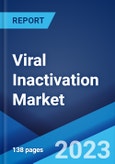The global viral inactivation market size reached US$ 635.6 Million in 2023. Looking forward, the publisher expects the market to reach US$ 1.39 billion by 2032, exhibiting a growth rate (CAGR) of 9.09% during 2023-2032.
Biotherapeutic products contain viruses or they can become contaminated during the production process. Viruses are infectious particles that invade cells wherein they proliferate and result in various diseases. As a result, viral inactivation is widely used to inhibit coat proteins and degrade nucleic acid within the virus. At present, different methods of viral inactivation are available across the globe according to the characteristics of the virus and the type of biotherapeutic product. For instance, germicidal (UVC) light exposure helps inactivate viruses in hospitals and other critical public and military environments.
These standards are escalating the demand for viral inactivation to ensure the quality, safety, and efficacy of these products, thereby reducing the risk of cross-contamination. Apart from this, improved viral inactivation technologies and products are being employed in the food and beverage (F&B) industry to help control the transmission of enteric viruses and assure the safety of products. This, in confluence with the development of new physical methods like supercritical fluids, gas plasma, and pulsed electric fields, is anticipated to increase the reliability, convenience, and suitability of viral inactivation, thereby driving the market.
Biotherapeutic products contain viruses or they can become contaminated during the production process. Viruses are infectious particles that invade cells wherein they proliferate and result in various diseases. As a result, viral inactivation is widely used to inhibit coat proteins and degrade nucleic acid within the virus. At present, different methods of viral inactivation are available across the globe according to the characteristics of the virus and the type of biotherapeutic product. For instance, germicidal (UVC) light exposure helps inactivate viruses in hospitals and other critical public and military environments.
Viral Inactivation Market Trends:
Human blood is a source of medicinal products that assists in the prevention and treatment of life-threatening diseases. Rising concerns about the transmission of blood-borne viruses through plasma-derived medicinal products represent one of the significant factors influencing the need for viral inactivation around the world. Several procedures for viral inactivation are nowadays used to assure the safety of blood plasma-derived protein solutions. Moreover, governing agencies of numerous countries are introducing stringent regulatory standards at an early stage in the development of biotherapeutic products.These standards are escalating the demand for viral inactivation to ensure the quality, safety, and efficacy of these products, thereby reducing the risk of cross-contamination. Apart from this, improved viral inactivation technologies and products are being employed in the food and beverage (F&B) industry to help control the transmission of enteric viruses and assure the safety of products. This, in confluence with the development of new physical methods like supercritical fluids, gas plasma, and pulsed electric fields, is anticipated to increase the reliability, convenience, and suitability of viral inactivation, thereby driving the market.
Key Market Segmentation:
The publisher provides an analysis of the key trends in each sub-segment of the global viral inactivation market report, along with forecasts at the global, regional and country level from 2024-2032. Our report has categorized the market based on product, application and end use.Breakup by Product:
- Reagents and Kits
- Systems
- Services
Breakup by Application:
- Vaccines and Therapeutics
- Stem Cell Products
- Blood and Blood Products
- Tissue and Tissue Products
- Cellular and Gene Therapy
Breakup by End Use:
- Pharmaceutical and Biotechnology Companies
- CROs
- Academic and Research Institutes
- Others
Breakup by Region:
- North America
- United States
- Canada
- Asia-Pacific
- China
- Japan
- India
- South Korea
- Australia
- Indonesia
- Others
- Europe
- Germany
- France
- United Kingdom
- Italy
- Spain
- Russia
- Others
- Latin America
- Brazil
- Mexico
- Others
- Middle East and Africa
Competitive Landscape:
The competitive landscape of the industry has also been examined along with the profiles of the key players being Charles River Laboratories, Merck KGaA, Parker Hannifin Corp, Rad Source Technologies, Sartorius AG, SGS SA, Terumo Corporation, Texcell, Vironova AB and WuXi AppTec.Key Questions Answered in This Report:
- How has the global viral inactivation market performed so far and how will it perform in the coming years?
- What has been the impact of COVID-19 on the global viral inactivation market?
- What are the key regional markets?
- What is the breakup of the market based on the product?
- What is the breakup of the market based on the application?
- What is the breakup of the market based on the end use?
- What are the various stages in the value chain of the industry?
- What are the key driving factors and challenges in the industry?
- What is the structure of the global viral inactivation market and who are the key players?
- What is the degree of competition in the industry?
Table of Contents
1 Preface3 Executive Summary11 Value Chain Analysis13 Price Analysis
2 Scope and Methodology
4 Introduction
5 Global Viral Inactivation Market
6 Market Breakup by Product
7 Market Breakup by Application
8 Market Breakup by End Use
9 Market Breakup by Region
10 SWOT Analysis
12 Porters Five Forces Analysis
14 Competitive Landscape
List of Figures
List of Tables
Companies Mentioned
- Charles River Laboratories
- Merck KGaA
- Parker Hannifin Corp
- Rad Source Technologies
- Sartorius AG
- SGS SA
- Terumo Corporation
- Texcell
- Vironova AB
- WuXi AppTec
Methodology

LOADING...
Table Information
| Report Attribute | Details |
|---|---|
| No. of Pages | 138 |
| Published | August 2024 |
| Forecast Period | 2023 - 2032 |
| Estimated Market Value ( USD | $ 635.6 Million |
| Forecasted Market Value ( USD | $ 1390 Million |
| Compound Annual Growth Rate | 9.1% |
| Regions Covered | Global |
| No. of Companies Mentioned | 10 |









